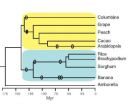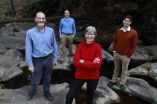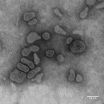(Press-News.org) DNA is the molecule that encodes the genetic instructions enabling a cell to produce the thousands of proteins it typically needs. The linear sequence of the A, T, C, and G bases in what is called coding DNA determines the particular protein that a short segment of DNA, known as a gene, will encode. But in many organisms, there is much more DNA in a cell than is needed to code for all the necessary proteins. This non-coding DNA was often referred to as "junk" DNA because it seemed unnecessary. But in retrospect, we did not yet understand the function of these seemingly unnecessary DNA sequences.
We now know that non-coding DNA can have important functions other than encoding proteins. Many non-coding sequences produce RNA molecules that regulate gene expression by turning them on and off. Others contain enhancer or inhibitory elements. Recent work by the international ENCODE (Encyclopedia of DNA Elements) Project (1, 2) suggested that a large percentage of non-coding DNA, which makes up an estimated 95% of the human genome, has a function in gene regulation. Thus, it is premature to say that "junk" DNA does not have a function—we just need to find out what it is!
To help understand the importance of this large amount of non-coding DNA in plants, Diane Burgess and Michael Freeling at the University of California, Berkeley have identified numerous conserved non-coding sequences (CNSs) of DNA that are found in a wide variety of plant species, including rice, banana, and cacao. DNA sequences that are highly conserved, meaning that they are identical or nearly so in a variety of organisms, are likely to have important functions in basic biological processes. For example, the gene encoding ribosomal RNA, an essential part of the protein-synthesizing machinery needed by cells of all organisms, is highly conserved. Changes in the sequence of this key molecule are poorly tolerated, so ribosomal RNA sequences have changed relatively little over millions of years of evolution.
To identify the most highly conserved plant CNSs, Burgess and Freeling compared the genome (one copy of all the DNA in an organism) of the model plant Arabidopsis, a member of the mustard family, with the genome of columbine, a distantly related plant of the buttercup family. The phylogenetic tree (see figure) shows the evolutionary relationships among the dicot (yellow) and monocot (blue) species they studied. Branch points represent points of divergence of two species from a common ancestor. Sequences in common between these two plants, which diverged over 130 million years ago, are likely to have important functions or they would have been lost due to random mutations or insertions or deletions.
They found over 200 CNSs in common between these distantly related species. In addition, 59 of these CNSs were also found in monocots, which are even more distant evolutionarily, and these were termed deep CNSs. Finally, they showed that 51 of these appear to be found in all flowering plants, based on their occurrence in Amborella, a flowering plant that diverged from all of the above plants even before the monocot-dicot split (see figure).
So what could be the function of these deep CNSs? We can get clues by analyzing the types of genes with which these CNSs are associated. The researchers found that nearly all of the deep CNSs are associated with genes involved in basic and universal biological processes in flowering plants—processes such as development, response to hormones, and regulation of gene expression. They found that the majority of these CNSs are associated with genes involved in tissue and organ development, post-embryonic differentiation, flowering, and production of reproductive structures. Others are associated with hormone- and salt-responsive genes or with genes encoding transcription factors, which are regulatory proteins that control gene expression by turning other genes on and off.
In addition, they showed that these CNSs are enriched for binding sites for transcription factors, and propose that the function of some of this non-coding DNA is to act as a scaffold for organization of the gene expression machinery. The binding sites they found are known sequences implicated in other plants as necessary for response to biotic and abiotic stress, light, and hormones. Furthermore, they discovered that a number of the CNSs could produce RNAs that have extensive double-stranded regions. These double-stranded regions have been shown to be involved in RNA stability, degradation, and in regulation of gene expression. Twelve of the most 59 highly conserved CNSs are associated with genes whose protein products interact with RNA. Clearly, these DNA sequences are not merely "junk!"
Now that Burgess and Freeling have identified the most highly conserved non-coding DNA sequences in flowering plants, future scientists have a better idea of which regions of the genome to focus on for functional studies. Do the predicted transcription factor-binding sites actually bind known or novel transcription factors? Do CNSs organize or regulate the gene expression machinery? Do CNSs encode RNAs that regulate fundamental processes in plants? The answers to these and many related questions will be easier to answer now that we have this set of deep CNSs that are likely to play important roles in basic cellular processes in plants.
INFORMATION:
References
(1) National Human Genome Research Institute (see http://www.genome.gov/10005107)
(2) Genome Research, Vol. 17, June 2007, special issue on ENCODE.
Author:
Gregory Bertoni
gbertoni@aspb.org
Science Editor, The Plant Cell
American Society of Plant Biologists
This work was supported by The National Science Foundation (IOS1248106).
Full citation: Burgess, D., and Freeling, F. (2014). The most deeply conserved noncoding sequences in plants serve similar functions to those in vertebrates despite large differences in evolutionary rates. Plant Cell 10.1105/tpc.113.121905.
New functions for 'junk' DNA?
Non-coding DNA sequences found in all plants may have undiscovered roles in basic plant development and response to the environment
2014-03-31
ELSE PRESS RELEASES FROM THIS DATE:
Hybrid vehicles more fuel efficient in India, China than in US
2014-03-31
What makes cities in India and China so frustrating to drive in—heavy traffic, aggressive driving style, few freeways—makes them ideal for saving fuel with hybrid vehicles, according to new research by scientists at the U.S. Department of Energy's Lawrence Berkeley National Laboratory (Berkeley Lab). In a pair of studies using real-world driving conditions, they found that hybrid cars are significantly more fuel-efficient in India and China than they are in the United States.
These findings could have an important impact in countries that are on the brink of experiencing ...
Behind the scenes of the IPCC report, with Stanford scientists
2014-03-31
In the summer of 2009, Stanford Professor Chris Field embarked on a task of urgent global importance.
Field had been tapped to assemble hundreds of climate scientists to dig through 12,000 scientific papers concerning the current impacts of climate change and its causes.
The team, Working Group II, would ultimately produce a 2,000-page report as part of a massive, three-part U.N. Intergovernmental Panel on Climate Change (IPCC) Fifth Assessment Report, which details a consensus view on the current state and fate of the world's climate.
The job would take nearly five ...
USC Viterbi researchers developing cheap, better-performing lithium-ion batteries
2014-03-31
Researchers at the USC Viterbi School of Engineering have improved the performance and capacity of lithium batteries by developing better-performing, cheaper materials for use in anodes and cathodes (negative and positive electrodes, respectively).
Lithium-ion batteries are a popular type of rechargeable battery commonly found in portable electronics and electric or hybrid cars. Traditionally, lithium-ion batteries contain a graphite anode, but silicon has recently emerged as a promising anode substitute because it is the second most abundant element on earth and has ...
New non-surgical treatment for common, vexing eye condition
2014-03-31
Baltimore, MD, 31 March 2014. – A new report reveals a potential breakthrough in the treatment of a common eye ailment known as pterygium (Surfer's eye) that impacts the vision, eye health, and cosmetic appearance of countless sufferers.
The newly published report shows that eye drops containing the anti-anginal drug dipyridamole (Persantin®, Cardoxin®) led to almost total disappearance of an inflamed pterygium in a 35 year old otherwise healthy woman.
Dipyridamole is a drug in use over the past 55 years to treat other disorders, but now found to have this remarkable ...
Lowering your cholesterol may improve your sex life
2014-03-31
A new Rutgers study is giving hope to older men concerned about the effects of cholesterol-lowering medications on their sexual health.
The research, conducted at Rutgers Robert Wood Johnson Medical School, found that statin medication prescribed to lower cholesterol and decrease the chance of heart attack and stroke, also improves a man's erectile function. The researchers reported their findings at the American College of Cardiology's annual scientific session in Washington DC March 29 and in the April issue of The Journal of Sexual Medicine.
"Older men who have poor ...
Genetic cause of heart valve defects
2014-03-31
Heart valve defects are a common cause of death in newborns. Scientists at the University of Bonn and the caesar research center have discovered "Creld1" is a key gene for the development of heart valves in mice. The researchers were able to show that a similar Creld1 gene found in humans functions via the same signaling pathway as in the mouse. This discovery is an important step forward in the molecular understanding of the pathogenesis of heart valve defects. The findings have been published in the journal "Developmental Cell".
Atrioventricular septal defect (AVSD) ...
Satellite shows high productivity from US corn belt
2014-03-31
Data from satellite sensors show that during the Northern Hemisphere's growing season, the Midwest region of the United States boasts more photosynthetic activity than any other spot on Earth, according to NASA and university scientists.
Healthy plants convert light to energy via photosynthesis, but chlorophyll also emits a fraction of absorbed light as fluorescent glow that is invisible to the naked eye. The magnitude of the glow is an excellent indicator of the amount of photosynthesis, or gross productivity, of plants in a given region.
Research in 2013 led by Joanna ...
Nearly 97 percent of health professionals wash their hands when patients are asked to watch: Study
2014-03-31
TORONTO, ON, March 31, 2014 --
Improving hand hygiene compliance by healthcare professionals is no easy task, but a first-of-its-kind Canadian study by researchers at Women's College Hospital shows simply asking patients to audit their healthcare professional is yielding high marks.
The study, published in the April edition of the American Journal of Infection Control, details the findings of an 11-month pilot project looking at an alternative method of hand hygiene auditing using the patient-as-observer approach. In this method, patients observe and record hand hygiene ...
Rural versus urban causes of childhood concussion
2014-03-31
Researchers at Western University (London, Canada) have found youth living in rural areas are more likely to sustain concussions from injuries involving motorized vehicles such as all-terrain vehicles and dirt bikes, whereas youth living in urban areas suffer concussions mostly as a result of sports. Hockey accounts for 40 per cent of those injuries. The study which reveals where and how children are receiving concussions is published in the Journal of Trauma and Acute Care Surgery.
Dr. Doug Fraser, a scientist with the Children's Health Research Institute at Lawson ...
Proteins discovered in gonorrhea may offer new approach to treatment
2014-03-31
CORVALLIS, Ore. – Researchers at Oregon State University have discovered novel proteins in, or on the surface of the bacteria that causes gonorrhea, which offer a promising new avenue of attack against a venereal disease that is showing increased resistance to the antibiotics used to treat it.
Only a single, third-generation cephalosporin antibiotic still shows good efficacy against gonorrhea, creating a race against time to find some alternative way to treat this disease that can have serious health effects. It's the second most commonly reported infectious disease in ...
LAST 30 PRESS RELEASES:
Air pollution exposure and birth weight
Obstructive sleep apnea risk and mental health conditions among older adults
How talking slows eye movements behind the wheel
The Ceramic Society of Japan’s Oxoate Ceramics Research Association launches new international book project
Heart-brain connection: international study reveals the role of the vagus nerve in keeping the heart young
Researchers identify Rb1 as a predictive biomarker for a new therapeutic strategy in some breast cancers
Survey reveals ethical gaps slowing AI adoption in pediatric surgery
Stimulant ADHD medications work differently than thought
AI overestimates how smart people are, according to HSE economists
HSE researchers create genome-wide map of quadruplexes
Scientists boost cell "powerhouses" to burn more calories
Automatic label checking: The missing step in making reliable medical AI
Low daily alcohol intake linked to 50% heightened mouth cancer risk in India
American Meteorological Society announces Rick Spinrad as 2026 President-Elect
Biomass-based carbon capture spotlighted in newly released global climate webinar recording
Illuminating invisible nano pollutants: advanced bioimaging tracks the full journey of emerging nanoscale contaminants in living systems
How does age affect recovery from spinal cord injury?
Novel AI tool offers prognosis for patients with head and neck cancer
Fathers’ microplastic exposure tied to their children’s metabolic problems
Research validates laboratory model for studying high-grade serous ovarian cancer
SIR 2026 delivers transformative breakthroughs in minimally invasive medicine to improve patient care
Stem Cell Reports most downloaded papers of 2025 highlight the breadth and impact of stem cell research
Oxford-led study estimates NHS spends around 3% of its primary and secondary care budget on the health impacts of heat and cold in England
A researcher’s long quest leads to a smart composite breakthrough
Urban wild bees act as “microbial sensors” of city health.
New study finds where you live affects recovery after a hip fracture
Forecasting the impact of fully automated vehicle adoption on US road traffic injuries
Alcohol-related hospitalizations from 2016 to 2022
Semaglutide and hospitalizations in patients with obesity and established cardiovascular disease
Researchers ‘listen in’ to embryo-mother interactions during implantation using a culture system replicating the womb lining
[Press-News.org] New functions for 'junk' DNA?Non-coding DNA sequences found in all plants may have undiscovered roles in basic plant development and response to the environment





